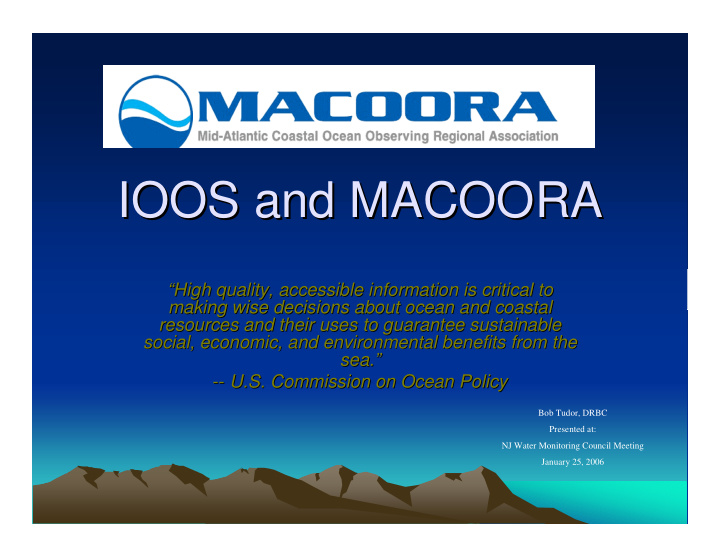



IOOS and MACOORA IOOS and MACOORA “High quality, accessible information is critical to “High quality, accessible information is critical to making wise decisions about ocean and coastal making wise decisions about ocean and coastal resources and their uses to guarantee sustainable resources and their uses to guarantee sustainable social, economic, and environmental benefits from the social, economic, and environmental benefits from the sea.” sea.” -- U.S. Commission on Ocean Policy -- U.S. Commission on Ocean Policy Bob Tudor, DRBC Presented at: NJ Water Monitoring Council Meeting January 25, 2006
Operational System to Serve Society’s Needs Operational System to Serve Society’s Needs The US Integrated Ocean Observing System – a US contribution to GEOSS and GOOS – is developing as a “user-driven’, integrated system of observations and data telemetry, data management and communications (DMAC), and data analysis and modeling that routinely, reliably, and continuously provides data and information required to: • Improve prediction of weather as well as climate change and variability and their impact on coastal communities and the nation; • Improve the safety and efficiency of marine operations; • More effectively mitigate the damaging effects of natural hazards; • Improve national and homeland security; • Reduce public health risks; • More effectively protect and restore healthy coastal marine ecosystems; • Sustain use of marine resources.
Integrated Ocean Observing Integrated Ocean Observing System (IOOS) includes: System (IOOS) includes: 1) Global Components 1) Global Components 2) Coastal Components 2) Coastal Components Some Global Components: ARGO Float Network El Nino Buoy Arrays Tsunami Detection Buoys
IOOS Coastal Components: IOOS Coastal Components: 1) National Backbone 1) National Backbone 2) National Federation of 2) National Federation of Regional Associations Regional Associations (NFRA) (NFRA) MACOORA is one of about a dozen Regional Associations in the National Federation
National Backbone Coastal Component Coastal Component • Operated by Federal Agencies Regional COOS’s • EEZ & Great Lakes • Core variables • Regional Associations � required by regions � Design • Networks � Operate � sentinel stations � reference stations • Involve private sectors, • Standards/Protocols NGOs, State Agencies � QAQC, DMAC � Design, Operate � Products � Use � Evaluate • Incorporate � Subregional systems � Elements thereof • Enhance the Backbone based on User Needs
The national ‘backbone’ provides common data The national ‘backbone’ provides common data most researchers and decision makers need . most researchers and decision makers need . National network components: • Buoys •C-Man Stations •PORTS installations •Remote Sensing •NERRS sites •EPA Bay Program
MACOORA Incorporates Existing MACOORA Incorporates Existing Subregional Observing Systems Observing Systems Subregional The Mid-Atlantic Coastal Ocean Observing Regional System includes: • Chesapeake Bay • Delaware Bay • New York Bight • Long Island Sound, and • Massachusetts and Rhode Island Bays
MACOORA is unifying entity for meeting user needs in MAB Region • Responsible for Building and Coordinating RCOOS • Augments Federal Backbone • Responds to Regional User Needs
MISSION MISSION MACOORA provides the means to quickly observe and forecast changes in the marine environment to make informed decisions for better protection and quality of life and livelihood by: ⋅ Facilitating geographic and data integration ⋅ Developing monitoring and forecast capabilities ⋅ Producing useful, reliable data-driven products
The Situation The Situation • Federal Backbone mostly in place • Most RCOOS’s initiated by Researchers • Neither set is replete with operational products ⎯ Chicken or Egg? • Funding sources vary, ~$50M in earmarks 2005 • Few (TABS….) have sustainable funding • Line-item Funding has yet to materialize – Wars – Disasters – Compelling Message?
STRATEGIC GOALS STRATEGIC GOALS ⋅ Goal #1: Integrate systems and data management ⋅ Goal #2: Build strong advocacy/funding for the region (planning, marketing) ⋅ Goal #3: Deliver reliable, useful products (early wins ⎯ regional success)
Strategy Strategy • Structure exists for going forward • Initial Activity Essentially Bootstrapping Adding to Assets • With combined voice, can carry compelling, unified message to Congress
Assets Assets • Regional Association Designation • People ? Users • 9 Coastal States − Water Quality − Emergency Management ⎯ Storm Surges, Waves,.. − Coastal Zone Management • Major Estuaries, Ports, and Harbors • Industries ⎯ − Navigation − Fisheries − Energy Production − Marine Recreation − ….
Assets, cont’d Assets, cont’d • Subregional Systems in place • NOPP Experience • Education ⎯ Outreach ⎯ Sea Grants, COSEE, NERRs • NEOS Heritage ⎯ Structure, Cooperation • HF Radar Network nearly complete
MARA Subregional Subregional Components Components MARA
Research Component Research Component • Required for both developing and mature systems • Supporting the development and refinement of forecast models • Process studies to improve observational power and deliver accurate information products • Refinement of Instrumentation and Observational Technique
Recommend
More recommend